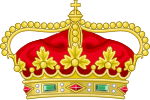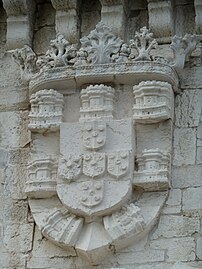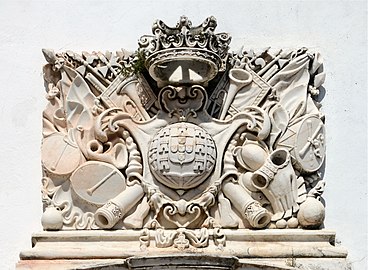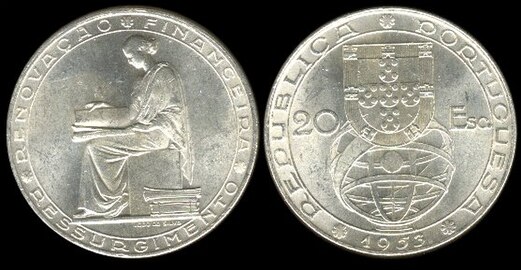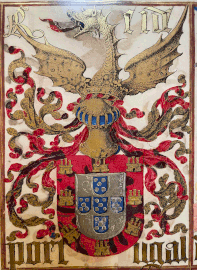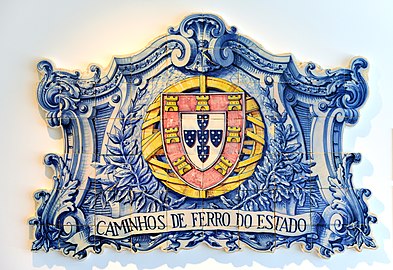Coat of arms of Portugal
This article includes a list of general references, but it lacks sufficient corresponding inline citations. (April 2008) |
| Coat of arms of Portugal | |
|---|---|
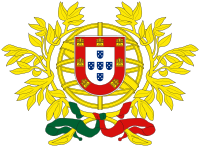 | |
| Versions | |
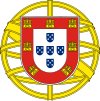 Version without laurel branches, for use on the national flag, naval jack and some governmental flags | |
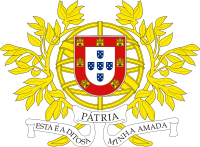 Version with the motto, for use on the national colors of the military units | |
Shield | Argent, five escutcheons in cross azure each charged with as many plates in saltire, all within a bordure gules charged with seven golden triple-towered castles |
| Motto | Esta é a ditosa Pátria minha amada ("This is my blissful beloved Fatherland") |
| Other elements | Behind the shield, an armillary sphere between two laurel branches embowed Or bound together in base by a ribbon vert and gules. |
The coat of arms of Portugal is the main heraldic insignia of Portugal. The present model was officially adopted on 30 June 1911, along with the present model of the Flag of Portugal. It is based on the coat of arms used by the Kingdom of Portugal since the Middle Ages. The coat of arms of Portugal is popularly referred as the Quinas (a quina being a group of five things).
Design
The present model of the coat of arms of Portugal was designed by the painter
Three versions of the coat of arms were established, intended for different types of use. All three include, as its central element, the shield of the traditional Portuguese arms placed over a golden armillary sphere.
The basic version consists of only the Portuguese shield over the armillary sphere. This version was intended to be used on the National Flag and on the naval jack. From the 23 September 1911, this version was also used on the naval distinctive flags of the President of the Republic, ministers and other state authorities, latter being also used on some governmental and state flags created afterwards. Occasionally, this version is unofficially referred as the "lesser arms of Portugal".
The second version consists of the Portuguese shield over the armillary sphere, with this being surrounded by two branches of laurel, tied in the base with a white scroll with the Camões verse Esta é a ditosa Pátria minha amada ("This is my beloved merry homeland"). This version was intended to be used on the regimental colors of the military units.
Finally, the third version is similar to the second one but the scroll does not include the verse and is usually represented in red and green. This version was intended to be used in seals, coins and other emblems.
Charges
Quinas
Quina (plural quinas) is the Portuguese word for quincunx.
After the
The number of silver bezants in each escutcheon varied extensively, with versions having represented from four up to eleven. In the late 14th century however, the number of bezants was fixed in five. Late explanations interpret them as the five wounds of
From the fixation of the number of bezants in five, the groups of the five escutcheons, each with five bezants of the Portuguese shield became popularly referred as quinas. By synecdoche, the term "Quinas" came to be used as an alternative designation of the coat of arms of Portugal and came even be used as a reference to anything that represents Portugal (e.g. the Flag of Portugal being often referred as the "Flag of the Quinas").
Castles
The red
External devices: Supporters
Armillary sphere
An important element of Portuguese heraldry since the 15th century, the armillary sphere was many times used in Portuguese naval and colonial flags, mainly in Brazil. It was a navigation instrument used to calculate distances and represents the importance of Portugal during the Age of Discovery, as well as the vastness of its colonial empire when the First Republic was implemented.
The use of the armillary predates the current flag by centuries. It was the personal emblem of King Manuel I. It was first added to the flag in 1815 as part of the flag of the United Kingdom of Portugal, Brazil and the Algarves.
The 1910 commission appointed by the government to study the symbols of the new republic suggested the armillary sphere as "the eternal standard of our adventurous spirit".[1]
Laurel branches
The original 1910 republican design of the coat of arms of Portugal incorporated a pair of laurel branches forming a wreath.[2] In some older renditions, the supporters are distinct.
History


The national heraldry of Portugal evolved from the royal heraldry, with the royal coat of arms gradually coming to be considered a national coat of arms.
The Portuguese coat of arms itself is the result of almost a millennium of modifications and alterations. Starting with the cross azur on field argent, which constituted the putative shield of
Evolution
The main and constant element of the coat of arms of Portugal is and has always been the Portuguese shield. This resulted from around 300 years of evolution, from the 12th to the 15th centuries.
The heraldic shield used by
The original shield evolved to Argent, five escutcheons crosswise the dexter and sinister ones pointing to the center azure each semée of plates (a field argent with five
Inescutcheons
There are several legends which seek to explain the significance of the five escutcheons and of the plates. The escutcheons are said to represent either the Five Holy Wounds of Christ on the Cross, the five wounds suffered by Afonso Henriques in the Battle of Ourique or the five Moorish kings defeated by him in that battle. The plates are supposed to represent either the pieces of silver received by Judas Iscariot to betray Jesus or the sovereignty of the Portuguese Kings, symbolized by the right to issue their own money. A more mundane theory suggests that the heraldry represents merely the physical fabric of the battle-shield of Afonso Henriques, which may have comprised two blue leather bands nailed to a white base; after having been repeatedly hit in battle, most of the bands had become cut off, except for the five pieces on top of the clusters of nails. These remaining five pieces of blue leather with the bright heads of the nails showing through, are thus proposed as the origin of the five escutcheons azur, each semée of plates.
Bordure

When the future
Cross of Aviz
During the
Escutcheons
Finally, in 1485, King
During some periods of effective or claimed Royal union of Portugal with other states, the Portuguese shield was used marshaled with the coats of arms of those states. Beatrice of Portugal, who claimed the Portuguese crown during the 1383-1385 interregnum, used the Portuguese arms in the II and III positions of the shield, marshaled with the arms of her husband King John I of Castile in the I and IV. King Afonso V of Portugal, who claimed the crown of Castile during the 1475–1479 period, used the Portuguese arms in the I and IV, marshaled with the arms of Castile and León in the II and III. During the period of the Iberian Union (1580–1640), the Portuguese shield was placed in the honour point of the complex coat of arms of the House of Habsburg. These marshaled coats of arms had, however, a very limited use, with the simple Portuguese coat of arms being used in the national context and the marshaled arms being only used when they intended to represent personally the monarch.
When the status of Brazil was raised from that of state to a constituent kingdom of the Portuguese Monarchy, giving origin to the United Kingdom of Portugal, Brazil and the Algarves, the Royal coat of arms was altered by the addition of an armillary sphere or over a field azur, these being the Brazilian arms. The new Royal achievement of arms consisted therefore of the Portuguese shield (representing Portugal and the Algarves) over the armillary sphere (representing Brazil), all topped by the Royal crown. Although displayed as a supporter of the Portuguese shield and not as part of it, it is controversial if the armillary sphere should be considered or not part of the main field of the new achievement. This achievement of arms was used in Portugal from 1815 to 1826 (despite Brazil having achieved independence in 1822, only when King John VI died in 1826 did Portugal revert to the use of the old coat of arms).
External devices
Until the early 14th century, the achievement of arms of Portugal consisted solely in the shield, with no external elements surrounding it being represented.
A crown over the shield started to appear in some representations of the Portuguese coat of arms in the 14th century. Initially, a crude open crown was represented, this evolving to a crown similar to the present
Other external elements surrounding the shield, started to be also represented in the Portuguese coat of arms from the 14th century, although none of them has reached the status of a constant element, as the Royal crown.
One of the most important of these elements was the heraldic crest, which at least from the reign of John I became a dragon, probably associated to the adoption of Saint George as the patron saint of Portugal. Until the 17th century, the dragon was represented in or, but since then, it started to be represented in vert. This change of color was probably due to the ascension to the throne, in 1640, of the House of Braganza, which had the green as its livery color, this also becoming the national color of Portugal. During the period of the House of Braganza, two dragons vert became frequently used as the supporters of the Portuguese Royal shield.
Other of the external elements was the helmet or with bars, that was frequently represented between the 14th and the 16th centuries, but rarely appearing in the achievement afterwards. Both the torse and the mantling that appeared in the helmet were represented in argent and gules during the reign of King Manuel I (1495-1521), these being his livery colors. In latter representations of the Royal achievement of arms, the torse and the mantling included the four colors of the Portuguese shield argent, gules, or and azur.
In the reign of King Manuel I, his personal
During the reign of
During the 1815-1825 period, the Royal coat arms were changed to reflect the establishment of the United Kingdom of Portugal, Brazil and the Algarves, starting to include also the armillary sphere or over a field azur, which was adopted as the coat of arms of the newly created Kingdom of Brazil. The new achievement consisted so of the Portuguese shield (representing Portugal and the Algarve) over the armillary sphere (representing Brazil), all topped by the Royal crown. The armillary sphere appeared so as a kind of supporter of the shield, although it is controversial if it should be really considered a supporter or part of the main element of the arms.
From the second half of the 19th century, the Royal coat of arms became commonly represented with the shield covered by a
issuing from the Royal crown.| Historical supporters and other external elements adorning the Portuguese coat of arms | ||||||||
|---|---|---|---|---|---|---|---|---|
| Dragon or crest, helmet or and mantling gules, or, azur and argent in a Thesouro da Nobreza armorial representation of the Portuguese achievement of arms | Angels as supporters of the 15th century shield (House of Aviz) | Cardinal hat on the top of the Portuguese arms used in the reign of King Henry | Green wyverns as supporters of an 18th century model shield (House of Braganza) | The armillary sphere as supporter of the Portuguese shield in the Coat of arms of the United Kingdom of Portugal, Brazil and the Algarves | Pavilion in a 19th century model coat of arms | Royal Coat of arms surrounded by a laurel wreath, commonly used in coins and official documents | Cross of the Order of Christ as the supporter of the Portuguese arms in the badge of the Order of the Colonial Empire | Supporters wearing a tabard bearing the badge of the Sash of the Three Orders and holding a banner of the cross of the Order of Christ and the standard of King Manuel I in a 20th century model coat of arms (Estado Novo) |
Notable depictions
-
Portuguese coat of arms, with the Cross of the Order of Aviz as supporter and the dragon as crest, in a late 14th-century gate of the Batalha Monastery
-
Manueline style coat of arms in the Belém Tower, Lisbon
-
Relief achievement of arms of theHouse of Habsburg at the El Escorial, Spain, with the Portuguese shield in the honour point
-
Lithograph of the Portuguese coat of arms carved on a boulder in Sri Lanka.
-
Coat of arms supported by Angel of Portugal in the Machado de Castro Museum, Coimbra
-
17th century coat of arms on the Prado bridge at Vila Verde
-
18th century coat of arms in the façade of the Misericórdia Church of Angra do Heroísmo
-
Baroque coat of arms on the portal of the Misericórdia Church of Braga
-
Stone relief the coat of arms of the United Kingdom of Portugal, Brazil and the Algarves in the Basilica of Bom Jesus in Braga
-
Trophy with the coat of arms of the United Kingdom of Portugal, Brazil and the Algarves in the façade of the Castle of Estremoz
-
Coat of arms in the 10 000 réis coin of 1884
-
(On the left) Portuguese coat of arms over the cross of the Order of Christ in the Cape Verde 2.5 escudos coin of 1967
-
1953 20 escudos coin.
-
Portuguese shield in the Codex Gottha, 1459
-
Represented in the Livro da Nobreza e Perfeição das Armas by António Godinho
-
20th century coat of arms painted on an azulejo panel at a train station
-
"Lieutenant Archangel holding the arms of Portugal" in a tile panel in the National Azulejo Museum
-
Royal coat of arms in a glass painting of the early 20th century
-
Coat of arms in the Chamber of Sessions of the São Bento Palace
-
Coat of arms in the plaque of the Portuguese consulate at Haifa
-
Monumental, modernist style coat of arms in a public building of 1940 (present Museum of the Orient) in Lisbon
-
Monumental coat of arms of Portugal at the Portuguese war cemetery in Neuve-Chappelle.
-
Royalist style Portuguese coat of arms on a column at Julio Bras Portuguese Park in Hayward, California
-
Portuguese arms carved on the Ielala Stone in Angola.
See also
- Portuguese heraldry
- Flag of Portugal
- History of Portugal
- Armorial of Portuguese colonies
- Coat of arms of Ceuta
References
- ^ Presidencia.pt: National Symbols. Official site of the Portuguese presidency.
- ^ Diário do Governo nº 150 – 30 June 1511 (PDF). presidencia.pt (in Portuguese).
- ^ Although long intended, chroniclers Ruy da Pina and Garcia de Resende date the change to a royal council held in Beja in 1485, when a new issue of royal coinage was decided and the shield adjusted for it. The chroniclers claim the coinage order was issued June 1485. See Garcia de Resende (1545) Crónica del-Rei D. João II, ch.57 [1902 ed, v.1, p.137].








